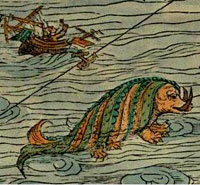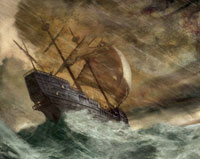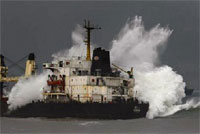 Last month we posted about The Great Gloucester Sea Serpent of 1817. Eric, a blog reader, commented, no doubt tongue in cheek, “So that is what the bloop was.” His comment got me thinking about the ironies of observations, technology and the unknown.
Last month we posted about The Great Gloucester Sea Serpent of 1817. Eric, a blog reader, commented, no doubt tongue in cheek, “So that is what the bloop was.” His comment got me thinking about the ironies of observations, technology and the unknown.
For the uninitiated, the “bloop” was an ultra-low frequency underwater sound detected by the U.S. National Oceanic and Atmospheric Administration (NOAA) several times during the summer of 1997. NOAA was using an acoustic hydrophone array in the Pacific ocean originally developed by the US Navy to track Russian submarines. The ”bloop” was heard on multiple sensors over a range greater than 5,000 km. The sound appeared to be somewhere around 50° S 100° W (in the Pacific of the southwest coat of South American). Scientists agreed that the bloop matches the audio profile of a living animal, but no known animal could have produced the sound. Also given the range across which the sound was heard, any animal that created such a sound would have to be significantly larger than a blue whale, the largest creature ever know to have lived on the planet.



 On Sept. 20, 1519, Portuguese navigator and explorer Ferdinand Magellan and his crew set out from Spain on five ships on a voyage to find a western passage to the Spice Islands in Indonesia. (Magellan was killed en route, but one of his ships eventually circled the world.)
On Sept. 20, 1519, Portuguese navigator and explorer Ferdinand Magellan and his crew set out from Spain on five ships on a voyage to find a western passage to the Spice Islands in Indonesia. (Magellan was killed en route, but one of his ships eventually circled the world.) While New York may have a great
While New York may have a great  Following up on our previous posts –
Following up on our previous posts –  The October 2009
The October 2009  SS Columbia, built in 1902, is the oldest surviving passenger steam vessel in the United States. The
SS Columbia, built in 1902, is the oldest surviving passenger steam vessel in the United States. The  Australian adventurer Don McIntyre and teenage circumnavigator Mike Perham to re-enact Capt William Bligh’s epic mutiny on the Bounty open boat voyage
Australian adventurer Don McIntyre and teenage circumnavigator Mike Perham to re-enact Capt William Bligh’s epic mutiny on the Bounty open boat voyage Sad news regarding a a remarkable woman and sailor.
Sad news regarding a a remarkable woman and sailor. Last year the
Last year the  Lee shores were long the bane of sailing ships. They are no better for motor vessels who lose their engines or drag their anchors. Table Bay where the SELI 1 grounded is just such a lee shore and has been a hazard for ships for hundreds of years. An interesting perspective from
Lee shores were long the bane of sailing ships. They are no better for motor vessels who lose their engines or drag their anchors. Table Bay where the SELI 1 grounded is just such a lee shore and has been a hazard for ships for hundreds of years. An interesting perspective from  “Super yachts” rarely impress me. Russian billionaire,
“Super yachts” rarely impress me. Russian billionaire, 

 From
From  I’ve always been struck by the tragedy that those most in need of ferry service are often also most at risk. We have seen recent ferry accidents in the Philippines with the sinking of the
I’ve always been struck by the tragedy that those most in need of ferry service are often also most at risk. We have seen recent ferry accidents in the Philippines with the sinking of the  If you can’t get sailors to church, bring the church to the sailors. That was the strategy used in 1844 by the Protestant Church Missionary Society for Seamen, which was renamed the
If you can’t get sailors to church, bring the church to the sailors. That was the strategy used in 1844 by the Protestant Church Missionary Society for Seamen, which was renamed the